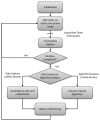A wearable inertial measurement unit for long-term monitoring in the dependency care area
- PMID: 24145917
- PMCID: PMC3859110
- DOI: 10.3390/s131014079
A wearable inertial measurement unit for long-term monitoring in the dependency care area
Abstract
Human movement analysis is a field of wide interest since it enables the assessment of a large variety of variables related to quality of life. Human movement can be accurately evaluated through Inertial Measurement Units (IMU), which are wearable and comfortable devices with long battery life. The IMU's movement signals might be, on the one hand, stored in a digital support, in which an analysis is performed a posteriori. On the other hand, the signal analysis might take place in the same IMU at the same time as the signal acquisition through online classifiers. The new sensor system presented in this paper is designed for both collecting movement signals and analyzing them in real-time. This system is a flexible platform useful for collecting data via a triaxial accelerometer, a gyroscope and a magnetometer, with the possibility to incorporate other information sources in real-time. A µSD card can store all inertial data and a Bluetooth module is able to send information to other external devices and receive data from other sources. The system presented is being used in the real-time detection and analysis of Parkinson's disease symptoms, in gait analysis, and in a fall detection system.
Figures







References
-
- Culhane K.M., O'Connor M., Lyons D., Lyons G.M. Accelerometers in rehabilitation medicine for older adults. Age Ageing. 2005;34:556–560. - PubMed
-
- Ermes M., Parkka J., Mantyjarvi J., Korhonen I. Detection of daily activities and sports with wearable sensors in controlled and uncontrolled conditions. IEEE Trans. Inf. Technol. Biomed. 2008;12:20–26. - PubMed
-
- Foerster F., Smeja M., Fahrenberg J. Detection of posture and motion by accelerometry: A validation study in ambulatory monitoring. Comput. Hum. Behav. 1999;15:571–583.
-
- Najafi B., Aminian K., Paraschiv-Ionescu A., Loew F., Bula C.J., Robert P. Ambulatory system for human motion analysis using a kinematic sensor: Monitoring of daily physical activity in the elderly. IEEE Trans. Biomed. Eng. 2003;50:711–723. - PubMed
Publication types
MeSH terms
LinkOut - more resources
Full Text Sources
Other Literature Sources
Medical

